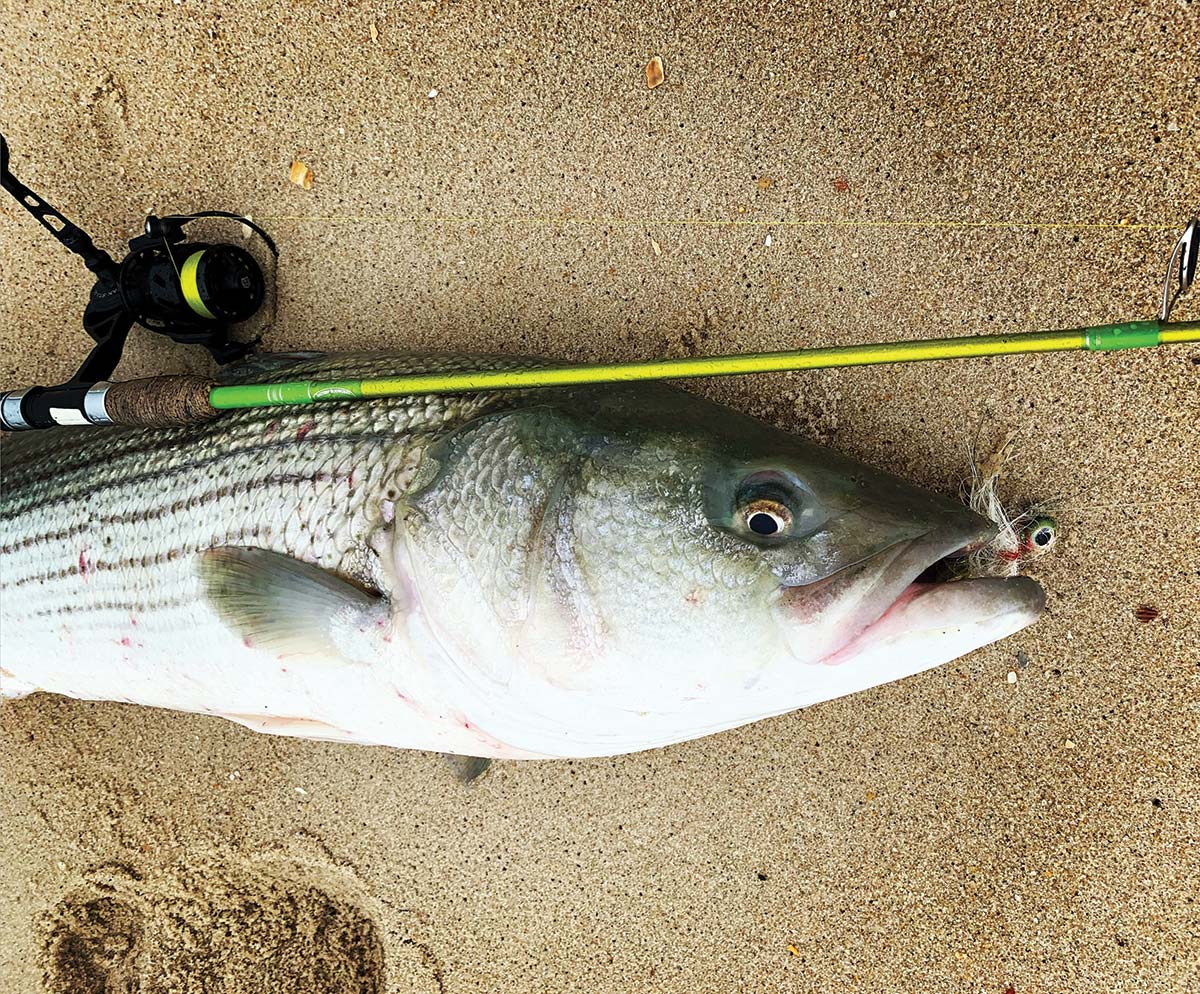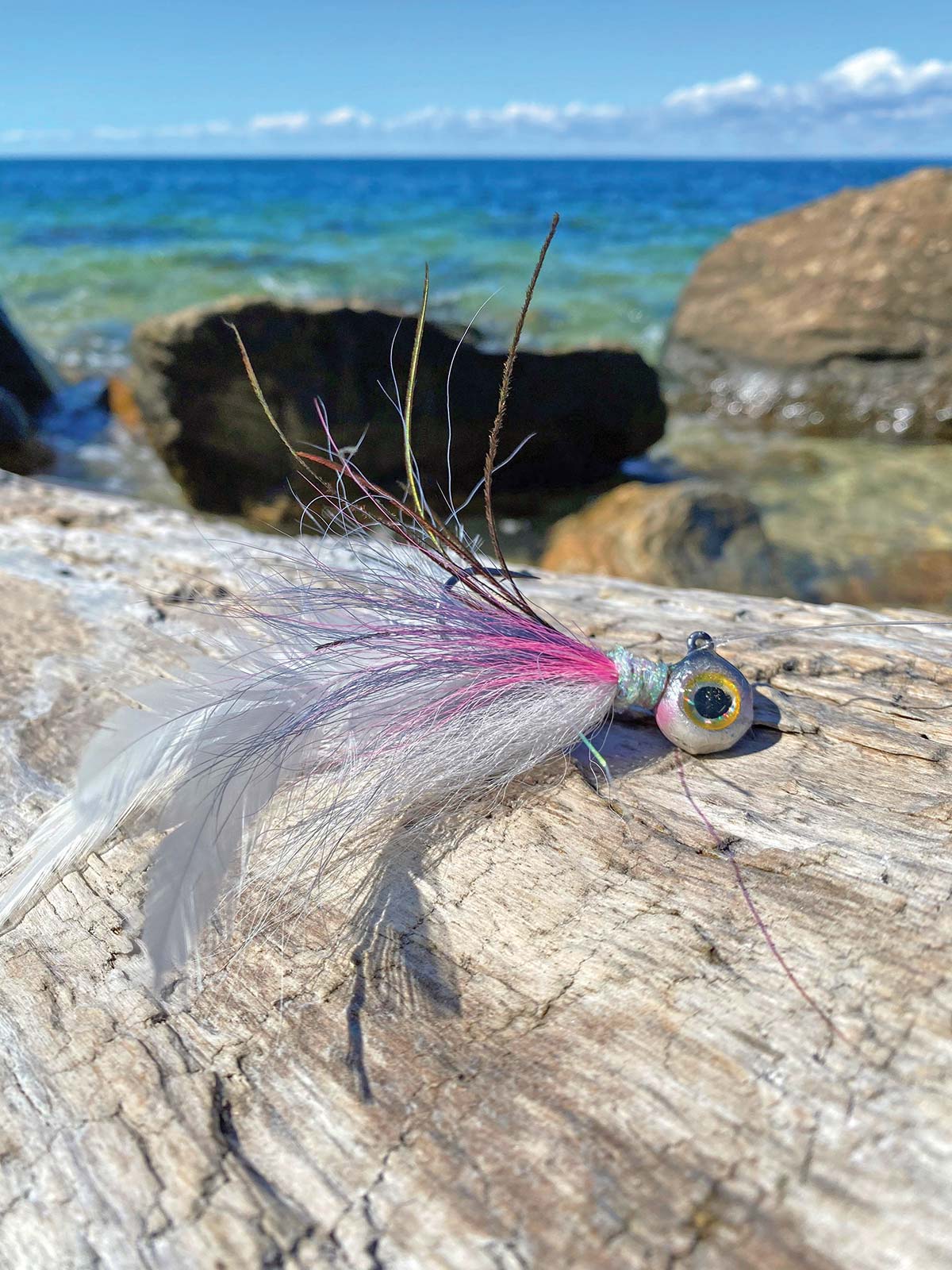
This proven technique is not only effective from a boat, but also in the surf.
Snap-jigging is a method originally coined by the late, great Fred Golofaro decades ago. If it wasn’t for Fred, I would probably still have kept this technique to myself and a few of my friends. He convinced me to share it with others and I am glad I listened to him. I thoroughly enjoy hearing the positive comments and how much anglers enjoy snap-jigging. Many of these anglers stating that they don’t want to fish any other way.
| SNAP-JIGGING WEBINAR |
| To see more on snap-jigging scan the QR code located in this article to watch an informative online seminar Capt. John Paduano gave on the subject of snap-jigging. Capt. John is also an establish Montauk charter captain who regularly takes clients out and gives hands-on lessons on the technique. To check his availability call 516-312-0372.
|
Snap-jigging appeals not only to the visual aspect of hunting for prey species but also the lateral line. The lateral line of a fish is an organ that uses a good percentage of a fish’s brain. The fact that it does indicates that must be a major attribute to a fish’s survival in helping it find and capture prey. If you ever watch bunker swim, do you notice how they stay equal distance from each other? Or how the whole school all turn and move at almost the same exact time? That’s because of the lateral line. They can actually feel what’s going on around them in the water— above, below and to the sides.
What snap-jigging does is appeal to both the fish’s sense of vision in mimicking the way a baitfish would normally act, with the way – or close to the way – that baitfish would “feel” to its lateral line. Most schooling baitfish like spearing, sand eels or bunker survive by out-swimming their siblings when attacked. They swim in short, hard bursts to get in front of the others – even when not in a school they will exhibit this swimming action when approached by predators. If that predator is a fish, it will expect this action and will expect to feel this action also. That predator also knows that the baitfish can only burst for a very short time before tiring which works well in a big school but not so much when alone. That fish understands it will be easy pickings in a second and expects the sudden slowdown and quick snack.
This action is what snap-jigging mimics and is exceptionally effective. I firmly believe that we can get fish to hit when they’re not in the mood in such conditions as slack tide or clear-blue, high pressure days. There have been times when we’ve been encircled by charter boats trolling to the extent we couldn’t leave to start another drift, because we were the only ones catching. “Only ones catching” is a phrase I hear often from snap-jigging groupies.

By Beach, As By Boat
We have the fall run upon us and this method will not only work along the Mid-Atlantic to New England coasts but anywhere fish predate upon other fish or crustaceans. It works equally well in fresh or saltwater. I’ve caught plenty of fish in New Jersey from Point Pleasant at Manasquan Inlet to Long Island beaches and inlets straight through to the New England coast. Snap-jigging is inherently adaptable to different conditions and environments because the lure, a bucktail, is adaptable.
One can adapt to different or changing conditions easily by changing the weight or hair density of a bucktail. Trying to explain in words how to snap-jig comes off as a very confusing, complicated method – it really isn’t – listening and using the tackle described will be of utmost importance. I’ve been doing this for close to 30 years and omitting one piece of the puzzle makes it very difficult to do. It does take some time to master but when you do the rewards will be worth it.
The tackle needed will be a 6-foot moderate action rod. Longer rods can be used in rougher conditions but we use 6-footers about 95% of the time. Longer and faster action rods will have your wrist aching in no time, resulting in sluggish snaps. Bright colored braid in 10-pound test is vital. It still amazes me how many people will not listen to this. I find it nearly impossible to fish anything but a bright colored line. Most of the information you use will be from sight of the line itself. Watching the line will tell you when you’re on the bottom or when you have a hit. This is nearly impossible with dark colored lines. Don’t be wary of the 10-pound test either. I have caught tarpon up to 200 pounds on 10-pound test.
When I first started surf fishing I, and other surf fishermen used 15-pound Andy mono for everything from inlets to beaches to Montauk lighthouse. Ten-pound braid actually has a greater breaking strength than 15-pound mono, especially after mono is a few days old. You will also need a reel with a great drag in the 2,500 to 3,000 size. Fluorocarbon leader from 25 to 30 pounds and jigs will finish this list.

From The Beach & Rocks
If you’re just learning or are still not great at it I would suggest going to a calm, quiet spot to practice. A surf scene with waves crashing, although totally fishable to a seasoned snapper will just result in frustration for a newbie. The biggest variable you will have is figuring out what weight jig to use. The choice is usually from 1/4- to 1-ounce jigs. Anything larger than an ounce usually results in ineffective snapping. The difference between shore and boat snap-jigging is that the weight of a jig is used for distance rather than accessing depth. A predicament is that oftentimes we are using a heavier than optimum size jig so that we can reach a bar or other structure resulting in a quicker than ideal retrieve. One way to minimize this is to use a slightly bulkier jig that has a bit more water resistance.
For the technique part of it, what you will do is cast out, close the bail while the rod is in the 11 o’clock position, and then watch the line as you slowly let the jig pull you down until you feel or see the line slumps as it hits bottom. Right here is where the most mistakes are made; follow the jig down so that the line is still relatively taut – most anglers have too much slack in the line. Too much slack will not allow you to feel bottom or feel a hit which always happens on the drop. Depending on where your rod is at the time the jig hits bottom, if it is at the 9 o’clock position take up some line with a half turn of the reel handle and then whip the rod up to the 11 o’clock position and repeat. Anytime your line jumps or hits bottom, snap it up. If it’s not bottom it’s a fish. This is one aspect of this method where you will develop a feel of how much line to take up in order to keep your jig near the bottom.

I like to cast out to bars and snap-jig off the bar into deeper water but if that doesn’t result in a fish, keep working it back until you’ve hit sand. A large percentage of the fish I catch will be in that last 20 feet of water. I have caught plenty of large fish to over 40 pounds, in the final few turns of the cast. When I do find the fish feeding in close I won’t hesitate to make some casts as close to parallel to the beach as I can depending on other fisherman and conditions. This will keep the jig in the strike zone for a longer percentage of time.
When fishing from jetties and breachways, depth and current comes into play a lot more than the open beach. The technique will still be the same but a cast uptide will be necessary. Initially the half turn or full turn of the reel handle will be needed until the jig gets down tide where it will be necessary to let line out in between snaps to keep the jig on the bottom. This method works exceptionally well at slack periods of the tide when nothing else does. Changing jig sizes to accommodate current and depth is important as I like to use the lightest jig possible to effectively fish bottom.

Not Just Stripers
There are some species that will hit jigs up in the water column – bluefish, albies, even bass when on a blitz. During these times, feeling bottom isn’t as important. I have found that in general the stripers, and specifically the larger stripers, will be hugging the bottom. We catch plenty of albies snap-jigging the bottom for bass and at times will fish bottom specifically for albies after they stop showing on top. Plenty of large fluke are caught from shore snap-jigging either while targeting bass or oftentimes fluke are the main target. We also get plenty of big blackfish, sea bass and porgies usually as a side catch.
| THE BUSINESS END |
| On the business end I feel there is nothing better than a bucktail. I feel that pork rind and plastic trailers, while excellent for night time bucktailing, do not allow for a quick snap due to the increased water resistance. Plain bucktails or ones with feathers allow for quicker response to your snap. Leadheads and straight-tail plastics, such as a Slug-Go and jerkbaits are great for beginners because they sink quicker than bucktails allowing for a quicker learning curve. It is extremely important to have the plastics on perfectly straight or an unnatural twist will occur on retrieve. Because of the bright colored braid I utilize a long section of fluorocarbon leader—about 5 to 6 feet tied with a Double-Uni Knot. You will need to learn how to cast with 4 or 5 feet of line hanging down also but it’s really not that hard once you practice the motion. – Capt. John |
Snap-jigging allows you to target many different species with the same tackle. Snap-jigging almost always out produces other methods such as tin and teaser but those methods still have their advantages when conditions are bad and the surf is high. Aside from those conditions there isn’t a more enjoyable way to catch and fight a fish. Face it, a 10-pound fish on an 11-foot rod isn’t all that much fun. A 10-pound fish on a snap-jigging set-up is a blast.
Snap-jigging comes easy to some and a bit more difficult to others. My worst students at one point are now my most accomplished fishermen. I find it much easier to teach newcomers. I will promise you this; learn snap-jigging and your fishing success will more than quadruple.
If you doubt me ask anyone you see snap-jigging on the beach this fall.




